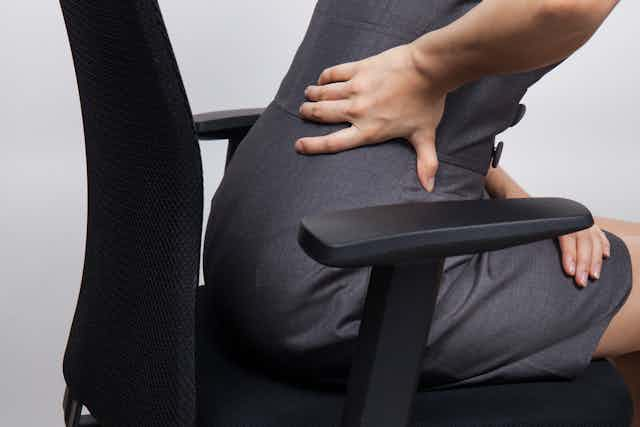Lower back pain is common and many of those who have suffered it can identify, or at least guess, the event that led to their back injury. Perhaps it was weekend sport or a garden project. Often a trip to the GP or physiotherapist will confirm suspicions and a suitable treatment regime follows.
For others, the cause is less certain. Roughly a quarter of patients under 45 years suffering ongoing lower-back pain (three months or more) without an obvious other cause will have the disease ankylosing spondylitis. This somewhat daunting name essentially means “fused and inflamed spine”.
Ankylosing spondylitis is quite different to other forms of lower back pain: it is not a result of mechanical or muscular injury.
Ankylosing spondylitis is a disease of chronic, inappropriate inflammation. In much the same way as other autoimmune diseases (such as rheumatoid arthritis or type 1 diabetes), sustained inflammation leads to tissue damage and a reduction in normal function.

A stark example in patients with severe ankylosing spondylitis is “bamboo spine”, the disturbingly vivid name for fused vertebrae; joined as a result of inflammation-induced bone growth.
Patients with less dramatic ankylosing spondylitis symptoms can still suffer terribly, and the impact on everyday activities and routine tasks can be quite major. Friendships, family relationships and sexual activity can all be affected as a result of fatigue, stiffness and pain.
The most common symptoms are chronic lower back pain and stiffness, often waking sufferers during the night, and typically being worse in the mornings. Alternating buttock pain is also a common sign.
People with ankylosing spondylitis can additionally experience pain and stiffness in their shoulders, chest, upper back, hips, knees and feet, and the disease can affect other organs, commonly the eyes.
In Australia, about 0.5% of the population suffer from ankylosing spondylitis and it is more commonly diagnosed in men; up to three times more often.
Ankylosing spondylitis is a serious disease and left untreated it can lead to prolonged suffering and permanent changes of the spine. The symptoms of ankylosing spondylitis appear gradually, usually when patients are in their late teens or early 20s.
Diagnosis
There is no cure for ankylosing spondylitis, but there are good management options, especially when patients are diagnosed early in the course of the disease and the destructive inflammation can be restrained. But herein lies the problem: a sizeable fraction of people with ankylosing spondylitis are only finally diagnosed after the disease has wreaked considerable damage.
It is not uncommon for ankylosing spondylitis patients to endure a decade between disease onset and definitive diagnosis, living with a great deal of hardship in the meantime. This is because chronic back pain is common in the community, and often caused by conditions other than ankylosing spondylitis, so the correct diagnosis is often overlooked.
Ankylosing spondylitis patients with more advanced forms of the disease will not only face reduced physical capacity and a decline in general well-being, they will also be much less responsive to treatment, because of the damage the disease has already caused to their spines.
The possibility of ankylosing spondylitis needs to be in the mind of GPs and physiotherapists when managing younger patients with persistent lower-back pain. Most of these patients won’t have ankylosing spondylitis, but a significant proportion do, and it’s important they are diagnosed correctly.
Increasing awareness of ankylosing spondylitis, and the appropriate care pathways, should be a priority of ongoing professional training.
Public awareness campaigns also have a role, such as the availability of online screening tools for back pain sufferers to assess the chances their own problems are due to ankylosing spondylitis. If ankylosing spondylitis is suspected, patients can be referred to a rheumatologist and, if a diagnosis of ankylosing spondylitis is made, management can start early.
Treatment
There are good treatment options for relieving the pain of ankylosing spondylitis sufferers. Current management includes patient education about the condition, how it may affect patients, and what sufferers can do to help themselves deal with the disease. Lifestyle adjustments such as changes to work patterns, a specific exercise program, and appropriate drugs can all be effective.
Most ankylosing spondylitis patients respond well to non-steroidal anti-inflammatory drugs, showing a reduction in both pain and inflammation. Those who don’t respond to non-steroidal anti-inflammatory drugs can often experience positive outcomes when treated with tumour necrosis factor inhibitor drugs.
These medications block tumour necrosis factor, a protein that is one of the main causes of inflammation in ankylosing spondylitis, and greatly reduce pain and other ankylosing spondylitis associated symptoms.
The most important thing is that health-care professionals become more aware of this disease so it doesn’t take so long to diagnose. With early diagnosis, treatment will be more effective, and sufferers can look forward to getting on with their lives.

